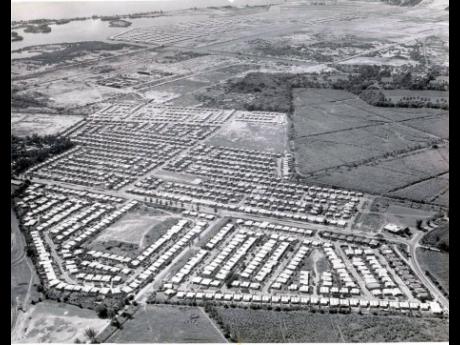Orrette Fisher | Should the ECJ have a say in determining the Portmore municipal boundaries?
The Government recently brought to Parliament proposed changes to the boundaries for the Municipality of Portmore. The opposition objected on the grounds that the Electoral Commission of Jamaica (ECJ) had not been consulted ahead of the proposed changes being tabled.
Before seeking to make a determination about which approach is right, there are certain factors that need to be highlighted.
The Local Governance Act 2015 section 9 clearly gives a municipal corporation, subject to the final approval of the local government minister, the right to determine the boundaries of towns, cities and villages.
The Electoral Commission Act Section 6 (1) (j) authorises the commission to make recommendations to Parliament for the setting or changing of constituency- and polling-division boundaries.
Section 6 (1) of the eighth schedule of The Representation of the People Act gives the ECJ the authority to set Electoral-Division boundaries.
The lines of authority seem to be crystal clear, with the Local Government Ministry having the power to set municipal boundaries and the ECJ the authority to administer electoral boundaries. So why is there a disagreement?
When the Portmore municipality was established in 2003, the boundaries were set by the St Catherine Parish Council in association with the minister of local government. However, with the decision for the municipality to have Jamaica’s first directly elected mayor, the Electoral Office of Jamaica (EOJ), and, by extension, the then Electoral Advisory Committee (EAC) were brought into the picture because the municipal boundary was now also an electoral boundary.
VERY UNTIDY SITUATION
Common sense, therefore, dictated, and both entities worked together to ensure that the boundaries conformed to existing electoral-division and polling-division boundaries to facilitate a smooth electoral process. Elections were conducted on the mutually agreed boundaries without any problems, starting in 2003.
Fast-forward to 2010, when three new constituencies were added in Jamaica, moving the total from 60 to 63. Two of the new constituencies were added to St Catherine, which had, over the years, seen a phenomenal rise in the population.
The shifting of the constituency boundaries to facilitate the additions resulted in the existing municipal boundaries cutting across constituency, electoral, and polling division boundaries. This resulted in the very untidy situation, where electors in sections of newly defined electoral divisions being able to vote for both the directly elected mayor as well as the councillor while some electors in the same division were only able to vote to elect the councillor.
The matter was further compounded by the fact that the Municipal Act, which existed at the time, stated that for a councillor to sit on the Portmore Municipal council, the electoral division represented must fall wholly within the boundaries of the municipality. The affected councillors who had parts of their divisions within the municipality were unable to represent these electors at the municipal council since they were prohibited by law from sitting on the Portmore Municipal Council.
So despite the fact that the majority of their constituents lived in the Portmore Municipality, these councillors were only able to sit at the St Catherine Parish Council.
This untidy situation was rectified by an amendment to the Municipal Act, which no longer required the entire division to fall within the boundaries of the municipality in order for a councillor to be able to take a seat at the municipal council.
PORTMORE PARISH PROPOSAL
The Government at the time, led by the Hon Bruce Golding, had publicly stated its intention to make Portmore into a parish. This proposal faced certain challenges since the Constitution clearly states in Section 2 (1) of the second schedule that a constituency shall not cross the boundary of a parish. With parts of the municipal boundary cutting across constituency boundaries, it meant that some constituencies would straddle the Parish of Portmore (if formed) and the existing parish of St Catherine. This would be in violation of the Constitution.
To rectify this problem, the EOJ proposed that the municipality be extended to include the constituencies of St Catherine Southern, St Catherine South Eastern, and St Catherine East Central. This would also be the boundaries of the new parish.
With a change in administration, the proposal to make Portmore into a parish was shelved, but the Government proceeded to adjust the boundaries of Portmore to coincide with the three constituencies. The process used to change the boundaries was successfully challenged leading up to the 2016 local government elections, resulting in the elections being conducted using the old boundaries.
This again saw electors in some divisions being able to vote for both the mayor of Portmore as well as a councillor, while others in the same divisions were only able to vote for the councillor.
The earlier amendment to the Portmore Municipal Act was retained in the Local Governance Act 2015, which meant that these councillors were allowed to sit on the Portmore Municipal Council. The electors who were only able to vote for a councillor were now being governed by a mayor whom they had no say in electing.
The recent proposed changes to the Portmore municipal boundaries are apparently aimed at addressing these issues. The Portmore municipality is unique, being the only municipality whose boundaries are also electoral boundaries. So while the authority to set the municipal boundaries ultimately rests with the local government minister, and the ECJ having a major role in the setting of electoral boundaries, it would seem natural for there to be some consultation since the ECJ ultimately has the responsibility of administering elections within those boundaries.
- Orrette Fisher is an election-management consultant and former director of elections. Email feedback to columns@gleanerjm.com.


